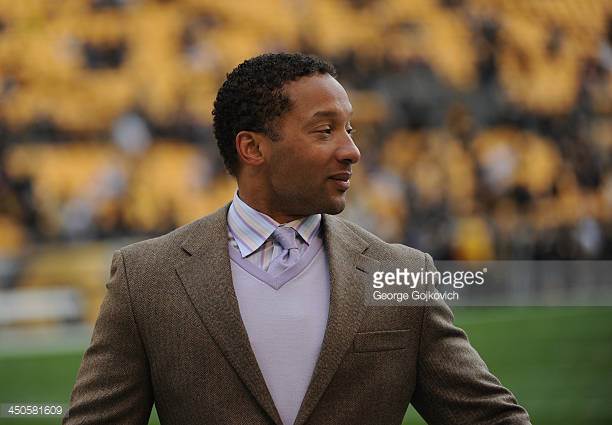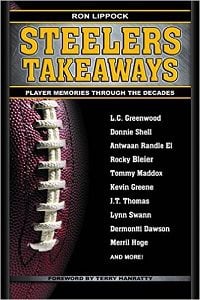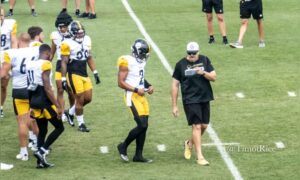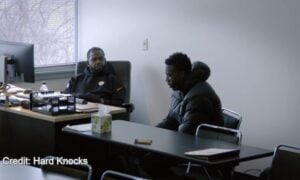Bringing you another Pittsburgh Steelers’ interview courtesy of our good friend Ron Lippock of the Pittsburgh Sports Daily Bulletin. Today, Ron talks with Doug Whaley, who served as the Pittsburgh Steelers’ Pro Scouting Coordinator from 1999 to 2009. He was named GM of the Buffalo Bills in 2013.
In the interview, the two discuss the two Steelers who helped Whaley early in his career, how the team’s draft process worked, and how Dan Rooney made Willie Parker a Steeler.
Be sure to check out Ron’s book, Steelers’ Takeaways: Player Memories Through The Decades, featuring over 400 interviews with players and coaches, past and present. You can buy it on Amazon through the link provided here.
First, tell us a bit about your new venture?
I’m working with a data company called Impellia (Ed Note: Check them out here). It’s actually a suite of platforms which makes it unique to help with injury prevention, sports performance, and the rehabilitation process for players. A lot of data companies are just one platform that regurgitates information. I chose to work with Impellia because it is different for two reasons.
First, you can incorporate every platform you use and integrate them all into it. That allows you to get historical data. The second is it’s fully customizable. Instead of us dictating the information, you can make it what you want it to be to search for what you need to look for. And the people. Rick, Charlie, and Dave – that’s a great cast of minds to join!
Looking at your scouting career – you started as an intern for the Steelers. What did you learn that helped shaped your career as a scout and later as a GM?
I learned the business from the bottom up. From picking up players at the airport, taking them to doctors appointments…I learned every step of the personnel process side of the business. I wouldn’t trade it for the world. I got to know what to expect about every part of the business and knew what to expect for the scouts. Talking to players, scouting visits, workouts…I learned the ins and outs of the evaluation process to make sure I knew what scouts needed to do.
Who really helped you in your career the most during that time, and how?
Bill Nunn and Charles Bailey. Those two set the course for my career. The main things they taught me were to be true to what you see. Have data to back it up and know that sometimes you may be wrong. But don’t waiver. On the flip side, when you are wrong, be the first to admit it. Don’t try to make up for being wrong by trying not to be responsible for it. These are the two things I hang on to every day.
I wanted to ask you about character. It seems fans often misunderstand what is meant by character when it comes to who the Steelers have interest in. Do you think that is the case?
Absolutely. Character means different things. It’s a combination in Pittsburgh – football character and off-the-field character. Football character is what we did a really good job of looking for when I was there. That means that their whole agenda should be about being the best they can be to help the team win a Super Bowl. In the training room, weight room – everything should be about helping the team win.
In today’s world, everybody is a reporter or has an opinion they can share with millions of people. Fans need to remember that the players are human beings, and humans are inherently unpredictable. You can have a lot of historical background on how someone has acted, but people react to different things in different ways so you never know about a person’s character 100%.
What did you personally look for most in a player you scouted?
Every scout has a different style. I didn’t care what a player did. I cared how they did it. If it was a receiver, I didn’t care if they caught a pass. I cared if they exploded off of the line, did they have burst in their break, how they tracked the ball… The technical part is on the coaches to teach. But the athleticism of the player is what scouts determine.
And the player’s mental approach?
You have to talk to coaches, academic advisors…everyone they work with at the school. The combine is more for this too – sitting down with them to understand their mental and medicals. The Spring is key because of the face-to-face meetings.
Did it matter if they were big or small school players? How so?
It didn’t matter – it was about the player’s ability. One thing we looked for in smaller school guys was how they played in the All-Star games. Did they show that they belonged with the NFL caliber players. Was the stage not too big for them – did they feel comfortable? That’s what gives scouts trepidation but that goes to that first principle I talked about earlier. Be true to what you see.
How did you approach free agency and player evaluation of NFL players? How was that different?
In the pro department you try to come up with reports on any player who took major snaps in the league. Guys may be on the trade block, are free agents, or may be cut. You have to canvas the whole league and you never get everyone because every day someone new is on the street.
The biggest difference is that the free agents are in their second or third contracts usually. Usually we see these as players who have reached their potential. It’s not about potential like it is in college. It’s more now about how they fit into what you are trying to do. And about their value relative to your cap room. It’s an intricate process in that you have to get involved with the agent and the negotiation process and mold it all together.
How did you recruit free agents to make them want to come play for the Steelers?
I can only comment on the time I was there – more of an historical view. It was all about the type of player we went after. It wasn’t about parades and glitter. It was about going after guys that cared about the trophies and the team. So that’s what we did. We sat them down and talked football and showed them the trophies and the locker rooms. That was the agenda. We wanted them to know our culture and what we’re about.
Tell me about the college draft process in Pittsburgh?
It was a daunting process. A lot of man hours and money for five-to-seven draft picks. It starts the year before when we go to the BLESTO meetings and they give us a list of all the guys in college they think we should look at. Then the college scouting director and Colbert break up the schools by scouts and they go pound the road. They go watch games and practices and get all of their evaluations and information together and meet. Then they do background checks and character checks on those players we planned to talk about. Then we go to the combine and All-Star games.
On the personnel side we always looked at it that it didn’t matter if we were wrong or right in September. We just needed to be right on draft day. It’s a long process and you get information late in the process that may change opinions. It always amazes me that one team may look at a guy as a third rounder and another team sees them as a first rounder.
How do such discrepancies in evaluations exist?
It’s the subjectiveness of the business. I always compared it to models. Everyone sees a supermodel and knows they are a supermodel. But the TV ad models and B-list celebrities are like the second and third rounders. Those all change in ranking according to opinion. What you like in a model or player I may not. And the vision and value of each in terms of where they should be drafted shift from guy to guy. Fitting their value with your vision matters too. Coaches don’t always see the entire draft board like we do. That’s where the personnel people come in. We evaluate where they fit in the overall draft.
Give me a couple of good draft stories you remember?
Phil Kreidler did a lot of work on Nate Washington out of Tiffin. I went to his Pro day when he ran on a rubber track – that’s how some of those small schools are. Everyone knew Phil liked him and when Coach Cowher asked Phil if he was drafted. Phil said no. So Cowher told him to call him and sign him. The rest is history – Nate ended up playing ten or so years in the NFL.
Fast Willie Parker ended up starting for us. We knew that year that no highly ranked undrafted free agents would want to sign with us. We had Jerome Bettis, Duce Staley, and Amos Zereoue then. But Dan Rooney Jr. said he remembered this kid from North Carolina who was good in high school and had great speed. He said let’s go get him. The next thing you know he’s breaking the Super Bowl record for the longest touchdown run.
Any free agent signings that excited you most?
The one I think I was most excited about was getting James Farrior from the Jets. When he first got here it took time for him to transfer his skills from a 4-3 to 3-4 defense. When I saw him in the first couple of practices, I was like…oooh no… Then, once he clicked, he was great. When we recruited him he came in and I think he really liked the guys in the locker room and the team chemistry.
The Steelers have a reputation for being one of the most secretive teams in the NFL. True?
Today I think the secrecy is getting to be less and less as information overload is just happening in life in general. A lot of times people like to talk to the press. To their buddies. We just tried to do less of that. Some guys like to give out information and false information. It’s a tricky business especially around the draft. We always tried to get more information than we gave. To not give away the blueprint.
Did you ever give out false information in the name of secrecy?
I can neither confirm or deny that.
Lastly, life as a scout is taxing – lots of travel and long hours. How do you handle that, especially with a family?
It’s all I’ve known. Someone who grows up in the country will go to the city and ask how anyone can live there. And someone in the city who goes to the country asks the same thing. This was my second job ever and the lifestyle I’ve always lived. Since I started dating my wife, she knew that’s what I was about and it’s worked well for me so far!









